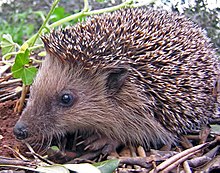Hedgehog
A hedgehog, also called a hedgepig or furze-pig, is a small mammal.[1] It has between 5000 and 7000 spines on its back. There are hedgehogs in Europe, Asia, Africa, and New Zealand. When attacked or threatened, it curls up. Hedgehogs eat insects, snails, frogs and toads, snakes, bird eggs, carrion, mushrooms, berries and melons. Sometimes, hedgehogs will search for earthworms after rainstorms.
| Hedgehogs[1] | |
|---|---|

| |
| European hedgehog | |
| Scientific classification | |
| Domain: | Eukaryota |
| Kingdom: | Animalia |
| Phylum: | Chordata |
| Class: | Mammalia |
| Order: | Eulipotyphla |
| Family: | Erinaceidae |
| Subfamily: | Erinaceinae G. Fischer, 1814 |
| Genera | |
- For the fictional character, see Sonic the Hedgehog
Hedgehogs are nocturnal animals and they hibernate between November and March.
Description change
Hedgehogs have long spines, or quills, made of keratin. They do not come off easily, unlike porcupines, but in baby hedgehogs, the baby quills drop off and are replaced with adult quills. This is called "quilling". When they are very stressed or sick, their quills can fall off, too. Their quills are not poisonous: they are safe for humans to feel and touch, as they are not very sharp, or harmful.
Pets change
Some people keep hedgehogs as pets. African pygmy hedgehogs are the most common type that are kept as pets. They live 2–4 years in captivity. Hedgehogs are exotic pets, which means they may not be legal to keep as pets in some places.
References change
- ↑ 1.0 1.1 Hutterer, R. (2005). "Order Erinaceomorpha". In Wilson, D.E.; Reeder, D.M (eds.). Mammal Species of the World: A Taxonomic and Geographic Reference (3rd ed.). Johns Hopkins University Press. pp. 212–217. ISBN 978-0-8018-8221-0. OCLC 62265494.
Other websites change
- Hedgehogs (Species) at the Open Directory Project
- Hedgehog reference at the University of Michigan Museum of Zoology
- Hedgehog Facts Archived 2008-12-06 at the Wayback Machine
- Hedgehog Care and Advice Archived 2011-08-16 at the Wayback Machine